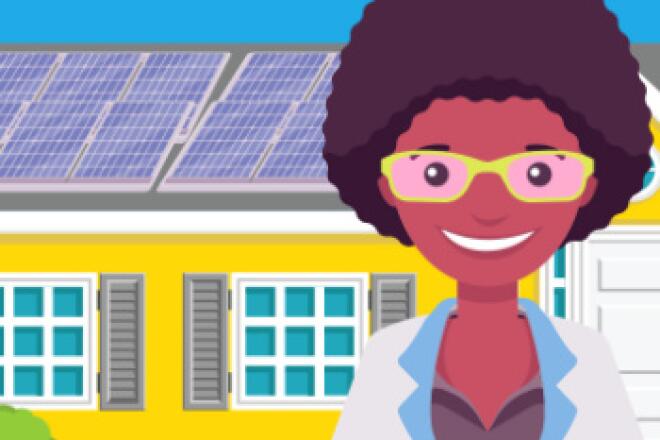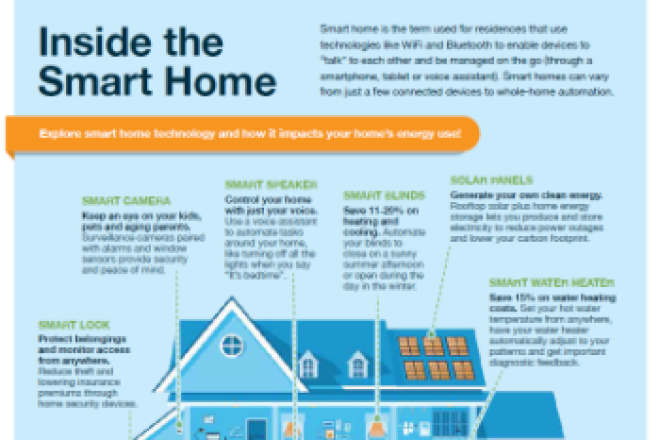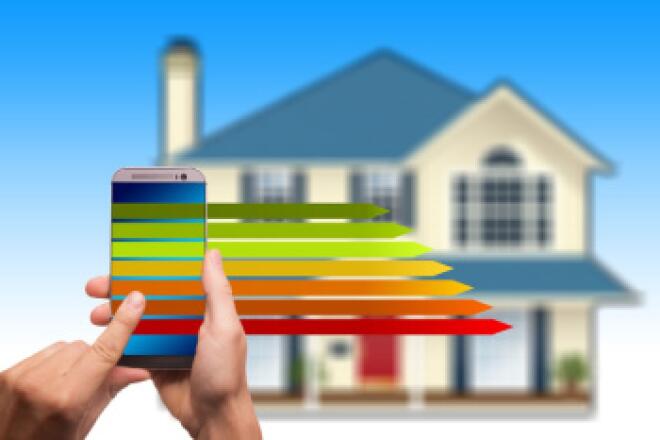
How We Use Energy
Energy is a fundamental part of our day-to-day lives. We use energy to light, heat and cool our homes, transport us, communicate with others and power our everyday activities. Most of us take for granted that when we flip the switch, the lights go on. But did you know the electricity system that provides power is changing dramatically?
There are many advancements that affect how we use energy. Read on to learn more about some of these amazing innovations.
Smart homes automatically adapt to the needs and preferences of their occupants
Thinking about when you use energy, not just how much
Increasingly, utilities across the U.S. are adopting what are known as time-of-use (TOU) electric rates for their residential customers. During some periods of the day, demand for electricity is high — say, when people are coming home from work, starting dinner, turning on the TV, etc. At other times, like in the middle of the night, demand for electricity is low because most people are sleeping. During these times, the supply of electricity is plentiful, and the cost of producing electricity is relatively cheap.
 Smart thermostats like those from Nest and ecobee help you manage your energy use by connecting to your home’s wireless internet network allowing you to control your thermostat from any internetconnected device. This feature means you can turn on your air conditioning while you are on your way home from work, or even turn it off from your hotel if you forgot to turn it off before leaving for a long weekend. Due to their advanced controls, smart thermostats can save customers up to 15% on their heating and cooling bills and on average, customers save about $140 a year after switching to a smart thermostat. If you are on a TOU rate plan and have watchful eye, these gadgets can save you even more money on your electricity bill.
Smart thermostats like those from Nest and ecobee help you manage your energy use by connecting to your home’s wireless internet network allowing you to control your thermostat from any internetconnected device. This feature means you can turn on your air conditioning while you are on your way home from work, or even turn it off from your hotel if you forgot to turn it off before leaving for a long weekend. Due to their advanced controls, smart thermostats can save customers up to 15% on their heating and cooling bills and on average, customers save about $140 a year after switching to a smart thermostat. If you are on a TOU rate plan and have watchful eye, these gadgets can save you even more money on your electricity bill.
Using smart, connected appliances and devices to control and manage energy use
Household appliances account for about 30% of household energy use because they’re always running,  and in the case of refrigerators, people are always opening and closing them. In addition, water heating accounts for 10% of an average household’s energy use. A smart fridge can determine when to defrost, helping shift energy use to times of lower electricity demand, and smart electric water heaters can serve as a type of battery that can not only store hot water for later use but manage when the water is actually heated — say, at night when electricity costs are usually cheapest benefitting you if you have a TOU plan.
and in the case of refrigerators, people are always opening and closing them. In addition, water heating accounts for 10% of an average household’s energy use. A smart fridge can determine when to defrost, helping shift energy use to times of lower electricity demand, and smart electric water heaters can serve as a type of battery that can not only store hot water for later use but manage when the water is actually heated — say, at night when electricity costs are usually cheapest benefitting you if you have a TOU plan.
A potentially fun example is smart window blinds that can be integrated with smart thermostats and home management devices like Amazon Echo or Google Home. The blinds can be set up to automatically close when it’s getting too hot or sunny or at night to reduce heat loss through the windows, or you can simply ask Alexa or Google to open or close the blinds whenever you want.
Helping homeowners make their homes more comfortable and energy efficient
Some say the cheapest energy is the energy you don’t use. Companies like Sealed with their HomeAdvance program, for example, will assess your home’s potential for energy savings and help you find innovative ways to pay for the desired home improvements. It’s a win-win situation for everyone. And utilities are investing in energy efficiency programs at the state and local levels to encourage a reduction of greenhouse gases and save you money. More information can be found on the American Council for an Energy-Efficient Economy’s State Energy Efficiency Policy Database.
Smart technologies are helping us be smarter and more energy efficient
 Smart technologies aren’t just for homes
Smart technologies aren’t just for homes
Smart technologies and sensors are also being used in commercial and industrial buildings. Architects and engineers are incorporating sensors into all sorts of equipment and processes such as pumps, HVAC equipment, food processing equipment and storage, conference rooms and elevators. And all the various sensors and equipment are being connected to sophisticated building management systems that are programmed when to turn the lights off if no one is in a conference room or adjust the air conditioning if someone opens a window. Smart systems also alert the building owner if an elevator,pump or something else in the building starts misbehaving.
 Predicting power outages before they happen using advanced analytics
Predicting power outages before they happen using advanced analytics
IBM and other companies are combining powerful computers and software with low-cost electronic sensors to monitor the status of millions of energy-related devices and equipment. These capabilities are used to analyze and predict potential power outages so that utilities and other energy providers can fix problems before they happen. These technologies, along with more than 70 million smart electric meters installed in homes and buildings across the country, are helping to both reduce the number of power outages and the duration of those that do occur.
Even cities are getting smarter
 Leveraging technology to make cities safer, cleaner and more efficient
Leveraging technology to make cities safer, cleaner and more efficient
City planners and other municipal leaders are using smart technologies to improve the lives of the more than 80% of Americans that live in urban areas. Cities are installing sensors on street lights, buildings and road signs to track energy use, public safety, traffic congestion, as well as the operation of lights, roads, bridges and more. City agencies are combining this information with powerful computer systems to predict and alleviate problems like traffic jams and equipment failures before they occur. The City of San Diego is working with General Electric to install sensors on over 3,200 street lights to monitor the operational status of the lights, monitor traffic flow crowd size and help control crime by pinpointing gunshots.
Choosing electric for transportation has never been easier
Although energy use in homes and commercial and industrial buildings accounts for most of the energy used in the U.S., energy use in the transportation sector accounts for nearly a third. So not surprisingly, innovations related to how we get around are hotbeds of activity.
 Skip the gas station, you can ‘fill-up’ on your terms
Skip the gas station, you can ‘fill-up’ on your terms
With no gas to buy, or oil to change, electric vehicles (EV) allow you to refuel by simply plugging in at home or at work. Electricity for your electric car is cleaner than gas and is increasingly being generated from renewable sources. Add a solar array to your home and your commute could be free and clean.
Making it easier and easier to charge your electric vehicle
The proliferation of electric vehicles is a classic chicken-and-egg problem: which comes first? The vehicles or the charging stations?  The answer, of course, is both, and as EVs like Teslas, Nissan LEAFs and Chevy Bolts become more commonplace, so are the options for charging them. Companies like ChargePoint and Blink are installing nationwide networks of charging stations that consumers can use to charge their vehicles along with apps that consumers can use to find the nearest charging station, turn it on and manage the charging process. And even more importantly, most major auto manufacturers are ramping up EV production in the coming years, with Volvo pledging that all of their car models will have electric motors by 2019.
The answer, of course, is both, and as EVs like Teslas, Nissan LEAFs and Chevy Bolts become more commonplace, so are the options for charging them. Companies like ChargePoint and Blink are installing nationwide networks of charging stations that consumers can use to charge their vehicles along with apps that consumers can use to find the nearest charging station, turn it on and manage the charging process. And even more importantly, most major auto manufacturers are ramping up EV production in the coming years, with Volvo pledging that all of their car models will have electric motors by 2019.
Getting the kids to and from school cleanly and quietly
Believe it or not, the average school bus route in the U.S. is only about 66 miles, but the Georgia-based Blue Bird sees an opportunity to make the daily trips quieter and cleaner. They’ve developed the All American RE electric bus with a range of up to 100 miles per charge. It looks like an ordinary yellow school bus but is quiet, powerful and emissions free, unlike a traditional diesel-powered school bus. And when the bus is done for the day, the driver plugs it in, and it’ll be ready to go again the next morning. No more dirty, noisy school buses rattling up and down the neighborhood.
So why should you care about all these innovations?
Innovations are happening all around us, including major innovations to the electricity industry that may not be as noticeable. You now have the ability to understand and control your electricity usage, decide which type of electricity you would like to buy and reduce your energy use through advanced technologies. These innovations will continue as we build a more connected and clean energy future together.
Download this fact sheet.
Watch the video.



